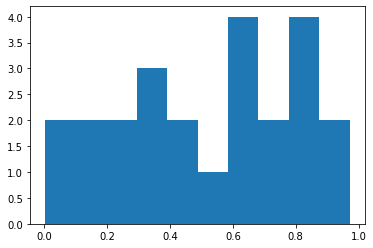딥러닝 데이터분석가 교육과정 필기_1주차
tensorflow 와 세션
import tensorflow as tf
def showvalue(t):
sess=tf.InteractiveSession() #대화형 세션
tf.global_variables_initializer().run() # 변수를 초기화한다
print(t.eval()) #변수를 평가해 ndarray로 값을 돌려줌
sess.close()
#Tensorflow의 3요소 : Constant(상수), Variebles(가중치를 저장한다), Placeholder (주입변수 : 실행시간에 전달되는 데이터를 feeding)
c2,c3 = tf.constant([1.2,5.6]),tf.constant([-4,-1,7])
v2,v3 = tf.Variable([2.3,4.5]),tf.Variable([-2,3,5])
#벡터 연산 : 요소 연산 (+,-,*,/), 내적연산 (내적 사이각)
#행렬 연산 : 행렬요소연산, 행렬곱연산 (내적의 연속) -> 차원감소, 특성추출 등
showvalue(tf.add_n([c2,v2])) # add : 2 개의 데이터 합
showvalue(tf.add_n([c3,v3,v3]))
showvalue(tf.sqrt(tf.cast(v3,tf.float64))) #cast : 형변환 함수. 상수를 실수형으로 변환
[ 3.5 10.1]
[-8 5 17]
[ nan 1.73205081 2.23606798]
- 결과값의 이유
3.5 = 1.2 + 2.3, 10.1 = 5.6 + 4.5 -8 = -4 + -2 + -2, 5 = -1 + 3 + 3, 17 = 7 + 5 + 5 nan = root -2, 1.73205081 = root 3, 2.23606798 = root 5
# matmul = matrix multiply (행렬곱)
c4 = tf.constant([[1,3,5],[0,2,4]])
showvalue(c4) #3, 3, 4, 2, 3 ... 행렬 형식이 길어도 맨 마지막에 있는 숫자가 열데이터 변수의 숫자를 의미 (3개)
v4 = tf.Variable([[1,2],[3,7],[8,9]]) #얘는 3x2 행렬
showvalue(v4)
showvalue(tf.matmul(c4,v4)) # 2x3 * 3X2 = 2x2 -> 차원축소 (특성추출)
showvalue(tf.matmul(v4,c4)) # 3x2 * 2x3 = 3x3 -> 차원확대 (다차원공간)
[[1 3 5]
[0 2 4]]
[[1 2]
[3 7]
[8 9]]
[[50 68]
[38 50]]
[[ 1 7 13]
[ 3 23 43]
[ 8 42 76]]
a = tf.eye(4) #단위행렬 = 행렬의 항등원. 행렬에는 나눗셈이 없으며 역행렬을 곱해서 사용 (행렬 x 역행렬 = 단위행렬)
r = tf.range(1,5,1)#1부터 5까지 1씩 증가하는 list
d = tf.diag(r) #대각행렬
showvalue(a)
showvalue(r)
showvalue(d)
[[1. 0. 0. 0.]
[0. 1. 0. 0.]
[0. 0. 1. 0.]
[0. 0. 0. 1.]]
[1 2 3 4]
[[1 0 0 0]
[0 2 0 0]
[0 0 3 0]
[0 0 0 4]]
#행렬을 초기화하는 함수
#세션함수
#할당함수
a = tf.Variable(tf.ones((2,2))) #ones : 1로 채워진 행렬, zeros : 0으로 채워진 행렬
a
sess = tf.Session()
sess.run(tf.global_variables_initializer()) #변수초기화
print(a.eval(session=sess))
sess.run(a.assign(tf.zeros((2,2)))) #변수에 값을 할당할 때 assign 함수 사용.
sess.run(a)
[[1. 1.]
[1. 1.]]
array([[0., 0.],
[0., 0.]], dtype=float32)
#matplotlib inline <- 주피터노트북에서 써야 이미지가 나옴
import tensorflow as tf
def run_variable(variable):
tf.global_variables_initializer()
with tf.Session() as sess:
return sess.run(variable)
my_distribution = tf.random_uniform((6,4),seed=42)
# random_uniform은 6x4개의 균등분포를 생성 (현재는 차이가 있어 보이지만, 600x4로 생성하면 거의 평평해짐)
# seed는 컴퓨터에서 정해놓은 의사난수. 같은 결과값을 보기 위해 seed 값을 부여
uniform=run_variable(my_distribution) # mdarray(numpy)로 출력.
#cf) 그냥 my_distribution을 print 찍으면 안 나옴. session을 돌려서 실행해야 함.
print(uniform)
from matplotlib import pyplot as plt
# 연속형 데이터를 구간별로 나누어 그래프화 해줌
plt.hist(uniform.flatten()) # flatten은 배열을 1차원으로 만들어줌. (cnn에서 사용)
plt.show()
[[0.95227146 0.67740774 0.79531825 0.75578177]
[0.4759556 0.6310148 0.18602037 0.11430776]
[0.3362218 0.723335 0.21919966 0.8573376 ]
[0.82392037 0.59541273 0.00296271 0.24725473]
[0.5060741 0.36158872 0.04483843 0.97216606]
[0.82838845 0.41458404 0.601666 0.33958685]]
 ```python
a = tf.constant([1,2,3,4,5,6],shape=[2,3])
b = tf.constant([7,8,9,10,11,12],shape=[3,2])
c = tf.matmul(a,b)#행렬곱
sess=tf.Session()
print(sess.run(a))
print(sess.run(b))
print(sess.run(c))
```python
a = tf.constant([1,2,3,4,5,6],shape=[2,3])
b = tf.constant([7,8,9,10,11,12],shape=[3,2])
c = tf.matmul(a,b)#행렬곱
sess=tf.Session()
print(sess.run(a))
print(sess.run(b))
print(sess.run(c))
[[1 2 3]
[4 5 6]]
[[ 7 8]
[ 9 10]
[11 12]]
[[ 58 64]
[139 154]]
```python
x = tf.constant([1,2,3,4,5,6],shape=[2,3])
x = tf.transpose(x)#전치행렬함수
print(sess.run(x))
[[1 4]
[2 5]
[3 6]]
c = tf.matmul(x, x) #Error 발생한다. 3x2 행렬과 3x2 행렬은 행렬곱연산이 불가능하기때문
---------------------------------------------------------------------------
InvalidArgumentError Traceback (most recent call last)
~\Anaconda3\lib\site-packages\tensorflow\python\framework\ops.py in _create_c_op(graph, node_def, inputs, control_inputs)
1863 try:
-> 1864 c_op = c_api.TF_FinishOperation(op_desc)
1865 except errors.InvalidArgumentError as e:
InvalidArgumentError: Dimensions must be equal, but are 2 and 3 for 'MatMul_3' (op: 'MatMul') with input shapes: [3,2], [3,2].
During handling of the above exception, another exception occurred:
ValueError Traceback (most recent call last)
<ipython-input-21-4a089fe6e183> in <module>
----> 1 c = tf.matmul(x, x)
~\Anaconda3\lib\site-packages\tensorflow\python\util\dispatch.py in wrapper(*args, **kwargs)
178 """Call target, and fall back on dispatchers if there is a TypeError."""
179 try:
--> 180 return target(*args, **kwargs)
181 except (TypeError, ValueError):
182 # Note: convert_to_eager_tensor currently raises a ValueError, not a
~\Anaconda3\lib\site-packages\tensorflow\python\ops\math_ops.py in matmul(a, b, transpose_a, transpose_b, adjoint_a, adjoint_b, a_is_sparse, b_is_sparse, name)
2645 else:
2646 return gen_math_ops.mat_mul(
-> 2647 a, b, transpose_a=transpose_a, transpose_b=transpose_b, name=name)
2648
2649
~\Anaconda3\lib\site-packages\tensorflow\python\ops\gen_math_ops.py in mat_mul(a, b, transpose_a, transpose_b, name)
5922 _, _, _op = _op_def_lib._apply_op_helper(
5923 "MatMul", a=a, b=b, transpose_a=transpose_a, transpose_b=transpose_b,
-> 5924 name=name)
5925 _result = _op.outputs[:]
5926 _inputs_flat = _op.inputs
~\Anaconda3\lib\site-packages\tensorflow\python\framework\op_def_library.py in _apply_op_helper(self, op_type_name, name, **keywords)
786 op = g.create_op(op_type_name, inputs, dtypes=None, name=scope,
787 input_types=input_types, attrs=attr_protos,
--> 788 op_def=op_def)
789 return output_structure, op_def.is_stateful, op
790
~\Anaconda3\lib\site-packages\tensorflow\python\util\deprecation.py in new_func(*args, **kwargs)
505 'in a future version' if date is None else ('after %s' % date),
506 instructions)
--> 507 return func(*args, **kwargs)
508
509 doc = _add_deprecated_arg_notice_to_docstring(
~\Anaconda3\lib\site-packages\tensorflow\python\framework\ops.py in create_op(***failed resolving arguments***)
3614 input_types=input_types,
3615 original_op=self._default_original_op,
-> 3616 op_def=op_def)
3617 self._create_op_helper(ret, compute_device=compute_device)
3618 return ret
~\Anaconda3\lib\site-packages\tensorflow\python\framework\ops.py in __init__(self, node_def, g, inputs, output_types, control_inputs, input_types, original_op, op_def)
2025 op_def, inputs, node_def.attr)
2026 self._c_op = _create_c_op(self._graph, node_def, grouped_inputs,
-> 2027 control_input_ops)
2028
2029 # Initialize self._outputs.
~\Anaconda3\lib\site-packages\tensorflow\python\framework\ops.py in _create_c_op(graph, node_def, inputs, control_inputs)
1865 except errors.InvalidArgumentError as e:
1866 # Convert to ValueError for backwards compatibility.
-> 1867 raise ValueError(str(e))
1868
1869 return c_op
ValueError: Dimensions must be equal, but are 2 and 3 for 'MatMul_3' (op: 'MatMul') with input shapes: [3,2], [3,2].
c = tf.matmul(x, tf.transpose(x))
print(sess.run(c)) # 3x2 행렬과 2x3행렬의 행렬곱연산. 행렬 자기자신을 제곱하려면, 자신의 전치행렬과 행렬곱을 해야 함
[[17 22 27]
[22 29 36]
[27 36 45]]
import numpy as np
a = tf.constant(np.arange(1,25,dtype=np.int32), shape=[2,2,2,3]) #열이 3개인 데이터가 2개씩 2개씩 2개
b = tf.constant(np.arange(1,25,dtype=np.int32), shape=[2,2,3,2]) #열이 2개인 데이터가 3개씩 2개씩 2개
c = tf.matmul(a,b) #행렬곱하면 2,2,2,2 shape행렬이 됨
print(sess.run(c))
a_1 = tf.range(1,25,1,dtype=tf.float32); a = tf.reshape(b,(2,2,2,3))
b_1 = tf.range(1,25,1,dtype=tf.float32); b = tf.reshape(b,(2,2,3,2))
c = tf.matmul(a,b)
sess.run(c)
[[[[ 22 28]
[ 49 64]]
[[ 220 244]
[ 301 334]]]
[[[ 634 676]
[ 769 820]]
[[1264 1324]
[1453 1522]]]]
array([[[[ 22, 28],
[ 49, 64]],
[[ 220, 244],
[ 301, 334]]],
[[[ 634, 676],
[ 769, 820]],
[[1264, 1324],
[1453, 1522]]]])
x = tf.constant([[[1, 2, 3],
[4, 5, 6]],
[[7, 8, 9],
[10, 11, 12]]])
print(sess.run(tf.shape(x))) #shape함수로 행렬의 형태 확인
y= tf.transpose(x,perm=[0,2,1]) #perm <- permute의 약자. 0: 면, 1 : 행, 2 : 열 --- 여기서는 행과 열을 바꾸라는 의미
print(sess.run(tf.transpose(x,perm=[0,2,1])))
print(sess.run(tf.matmul(x,y)))
[2 2 3]
[[[ 1 4]
[ 2 5]
[ 3 6]]
[[ 7 10]
[ 8 11]
[ 9 12]]]
[[[ 14 32]
[ 32 77]]
[[194 266]
[266 365]]]
tensor = [1,2,3,4,5,6,7,8,9,10,11,12]
print(sess.run(tf.reshape(tensor, [2,-1]))) # 2로 나눴을 때 나머지 차수가 -1 자리에 들어옴
t= tf.reshape(tensor, [-1,6])
print(sess.run(tf.reshape(tensor, [2,-1,3]))) # -1 자리는 컴퓨터가 계산해서 결정해줌
[[ 1 2 3 4 5 6]
[ 7 8 9 10 11 12]]
[[[ 1 2 3]
[ 4 5 6]]
[[ 7 8 9]
[10 11 12]]]
#Placeholder
import tensorflow as tf
import numpy as np
a = tf.placeholder(tf.int32, shape=[2], name="my_input")
#tensorboard, model 저장시 (why? 세션이 변하면 변수 a의 메모리상 주소값을 다시 불러야 하니까)
# 32비트짜리 데이터가 2개 들어올거라는 걸 지정해놓는 것. (메모리가 작은 상황에서 개발하다보니 이렇게 만들어놨음.)
b = tf.reduce_prod(a, name="prod_b") # 데이터를 모두 곱함
c = tf.reduce_sum(a, name="sum_c") # 데이터를 모두 합침
d = tf.add(b,c,name="add_d") # 데이터를 총합
sess = tf.Session()
input_dict = {a:np.array([5,3],dtype=np.int32)} #dictionary, set
sess.run(d, feed_dict=input_dict) #feeding할 때는 키-데이터 형식으로 전달.
23
#broadcasting
#행렬연산은 요소별로 계산하면 된다고 배웠음. 그런데 짝이 안 맞으면?
#프로그램이 알아서 4를 3개로(4,4,4) 전파(broadcasting)시켜서 연산함.
a = tf.constant([1,2,3], name='a')
b = tf.constant(4, name='b')
add_op = a + b
with tf.Session() as session :
print(session.run(add_op))
[5 6 7]
a = tf.constant([[1,2,3],[4,5,6]], name='a')
b = tf.constant([[10],[11]], name='b')
add_op = a + b
with tf.Session() as session :
print(session.run(add_op))
[[11 12 13]
[15 16 17]]
#문제. 호출방법 : add, feed_dict={a:2.b:3}
import tensorflow as tf
a = tf.placeholder(tf.int16)
b = tf.placeholder(tf.int16)
add = tf.add(a, b)
mul = tf.multiply(a, b)
sess = tf.Session()
sess.run(add, feed_dict={a:2,b:3})
5
# 임의의 10000개 난수로부터 실제 방정식을 추론하는 프로그램
x = tf.placeholder("float")
y = tf.placeholder("float")
w = tf.Variable([0.0, 0.0], name='w')
y_model = tf.multiply(x, w[0]) + w[1]
error = tf.square(y - y_model)
train_op = tf.train.GradientDescentOptimizer(0.01).minimize(error)
model = tf.global_variables_initializer()
with tf.Session() as session:
session.run(model)
for i in range(10000) :
x_value = np.random.rand()
y_value = x_value * 2 + 6
session.run(train_op, feed_dict={x:x_value, y:y_value})
w_value = session.run(w)
print("예측을 위한 모델 : {a:.3f}x + {b:.3f}".format(a=w_value[0], b=w_value[1]))
예측을 위한 모델 : 2.000x + 6.000

